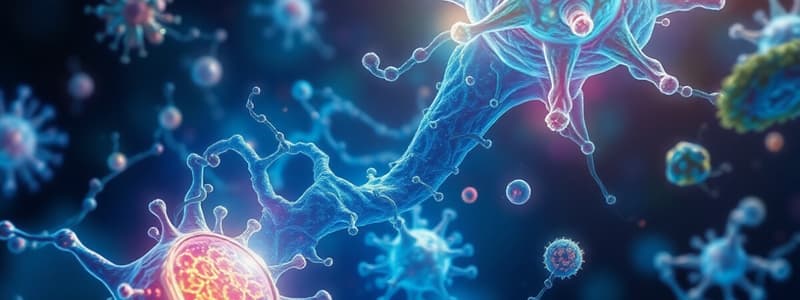Podcast
Questions and Answers
What is the main difference between aerobic and anaerobic respiration?
What is the main difference between aerobic and anaerobic respiration?
- Aerobic respiration requires oxygen, anaerobic does not. (correct)
- Aerobic respiration occurs in plants, anaerobic respiration occurs in animals.
- Anaerobic respiration is only used during exercise, aerobic respiration is used all the time.
- Anaerobic respiration produces more energy than aerobic respiration.
Which of the following is NOT a common reason for organisms to move?
Which of the following is NOT a common reason for organisms to move?
- To find food
- To escape predators
- To regulate body temperature (correct)
- To reproduce
What is the primary function of a nervous system?
What is the primary function of a nervous system?
- To break down food and release energy
- To produce new organisms
- To control and coordinate an organism's responses to stimuli (correct)
- To remove waste products from the body
Which of the following is NOT a level of classification used in taxonomy?
Which of the following is NOT a level of classification used in taxonomy?
What is a major environmental issue that threatens biodiversity?
What is a major environmental issue that threatens biodiversity?
What defines autotrophs in terms of nutrition?
What defines autotrophs in terms of nutrition?
Which of the following is a characteristic of living organisms?
Which of the following is a characteristic of living organisms?
What type of cells are prokaryotic cells?
What type of cells are prokaryotic cells?
What process do autotrophs use to produce food?
What process do autotrophs use to produce food?
Which structure in the cell is responsible for generating energy?
Which structure in the cell is responsible for generating energy?
What is the primary function of the cell membrane?
What is the primary function of the cell membrane?
Which statement about respiration is correct?
Which statement about respiration is correct?
What is the basic unit of life?
What is the basic unit of life?
Flashcards
Excretion
Excretion
The process of removing waste products from the body.
Movement in Living Organisms
Movement in Living Organisms
Organisms move for reasons like finding food, escaping danger, and mating.
Reproduction
Reproduction
The process of creating new organisms.
Control and Coordination
Control and Coordination
Signup and view all the flashcards
Biological Diversity
Biological Diversity
Signup and view all the flashcards
What is Biology?
What is Biology?
Signup and view all the flashcards
What is an Organ?
What is an Organ?
Signup and view all the flashcards
What is a Cell?
What is a Cell?
Signup and view all the flashcards
What is Metabolism?
What is Metabolism?
Signup and view all the flashcards
What is Homeostasis?
What is Homeostasis?
Signup and view all the flashcards
What is Reproduction?
What is Reproduction?
Signup and view all the flashcards
What is Photosynthesis?
What is Photosynthesis?
Signup and view all the flashcards
What is Respiration?
What is Respiration?
Signup and view all the flashcards
Study Notes
Introduction to Biology
- Biology is the study of life and living organisms.
- It includes various levels of organization, from molecules to ecosystems.
- Key areas of study include cells, genetics, evolution, ecology, and more.
Characteristics of Living Organisms
- Living things exhibit key characteristics:
- Organization: Complex, ordered structure.
- Metabolism: Chemical reactions to obtain and use energy.
- Growth and Development: Increase in size and Complexity.
- Adaptation: Evolving and adjusting to the environment.
- Response to Stimuli: Reacting to surroundings.
- Reproduction: Creating new organisms.
- Homeostasis: Maintaining a stable internal environment.
The Cell: The Basic Unit of Life
- All living organisms are made of cells.
- Cells are fundamental units of structure and function.
- Two main types: prokaryotic and eukaryotic.
- Prokaryotic cells are simpler and smaller.
- Lack a nucleus and other membrane-bound organelles.
- Examples: bacteria and archaea.
- Eukaryotic cells are more complex and larger.
- Have a nucleus and other membrane-bound organelles.
- Examples: animal and plant cells.
- Cellular structures and functions are critical:
- Nucleus: Controls cell activities.
- Cell membrane: Regulates what enters and exits the cell.
- Mitochondria: Generate energy.
- Chloroplasts (in plant cells): Conduct photosynthesis.
Tissues, Organs, and Systems
- Cells combine to form tissues.
- Examples: muscle, nervous, epithelial tissue.
- Tissues combine to form organs.
- Examples: heart, lungs, brain.
- Organs work together to form organ systems.
- Examples: circulatory, respiratory, digestive systems.
Nutrition
- Organisms obtain energy and nutrients through nutrition.
- Autotrophs produce their own food; heterotrophs obtain nutrients from others.
- Photosynthesis is key for autotrophs.
- Plants use sunlight to produce food from CO2 and water.
- Types of nutrition:
- Herbivores eat plants.
- Carnivores eat animals.
- Omnivores eat both plants and animals.
Respiration
- Breathing and respiration are linked, but distinct.
- Respiration is the process of releasing energy from food in cells.
- Aerobic respiration uses oxygen.
- Anaerobic respiration occurs without oxygen.
- Cellular respiration breaks down glucose and releases energy.
Excretion
- Excretion removes waste products from the body.
- Different organisms have varied excretory systems.
Movement in Living Organisms
- Organisms move for various reasons (food, predators, mating).
- Movement occurs through different mechanisms (muscle contractions, cilia, flagella).
Reproduction
- Reproduction creates new organisms.
- Asexual reproduction: One parent, genetically identical offspring.
- Sexual reproduction: Two parents, combined genetic material.
Control and Coordination
- Organisms respond to stimuli through control and coordination systems.
- Nervous and hormonal systems are crucial.
- Organisms can sense their environment.
Heredity
- Heredity is the transmission of traits from parents to offspring.
- Genetics studies heredity and variation.
Importance of Biological Diversity
- Biological diversity is the variety of life on Earth.
- It is important for the health of the planet and human well-being.
- Many species provide essential ecosystem services.
Classification of Living Organisms
- Living organisms are grouped based on similarities.
- Taxonomies organize these groups.
- Common classifications: kingdom, phylum, class, order, family, genus, species.
Environmental Issues
- Human activities impact the environment and biodiversity.
- Pollution, deforestation, and climate change are examples.
- Conservation efforts are essential for protecting biodiversity.
Studying That Suits You
Use AI to generate personalized quizzes and flashcards to suit your learning preferences.




